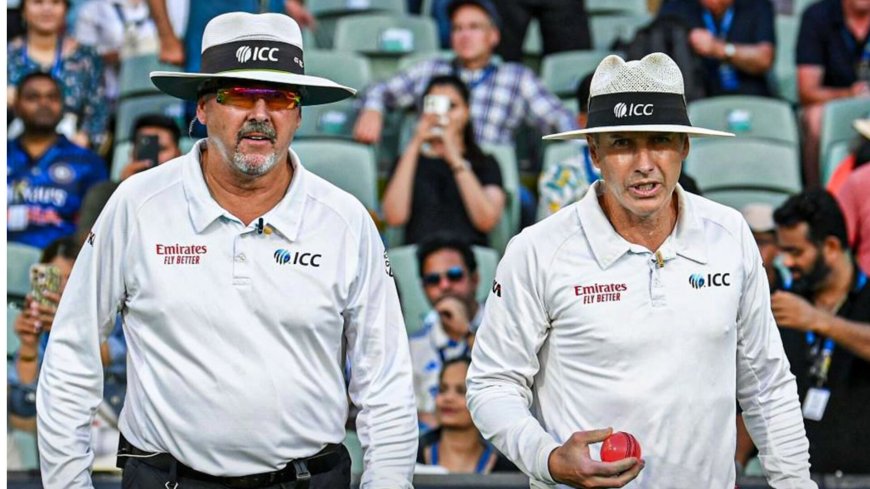ICC Reveals Major Rule Changes: Stop Clock to DRS Updates
While the new Test playing conditions have already come into effect with the 2025–27 WTC cycle, the white-ball changes will be enforced from July 2.

Delhi (India) June 26: The International Cricket Council (ICC) has rolled out a series of significant rule changes across all formats of men’s international cricket, including modifications to the Decision Review System (DRS), over-rate penalties in Tests, and updates to ball usage in One Day Internationals (ODIs). While the new Test playing conditions have already come into effect with the commencement of the 2025–27 World Test Championship (WTC) cycle, the white-ball changes will be enforced from July 2.
Here's a summary of the most notable adjustments across formats, as reported by ESPNCrifinfo:
Stop Clock Comes to Test Cricket
After its successful implementation in limited-overs cricket, the stop clock is now part of the Test format as a measure to tackle slow over rates — a long-standing issue. Fielding teams will be required to start a new over within 60 seconds of the previous one ending. Umpires can issue up to two warnings, after which a five-run penalty will be imposed for further delays. These warnings will reset after every block of 80 overs. The clock will count upward from 0 to 60 seconds.
Ball Change Rule Updated for Saliva Use
While the ban on saliva remains in place, the ICC has made it optional not mandatory for umpires to change the ball if saliva is applied. This move is aimed at preventing teams from intentionally applying saliva to manipulate ball replacement. Umpires will now assess whether the ball’s condition has significantly changed appearing wetter or shinier before opting to replace it. If they deem the condition unaffected, the ball will stay in play, and the batting side will be awarded five penalty runs. No further replacement will occur, even if the ball starts behaving unusually later.
DRS: Secondary Mode of Dismissal Now Carries Original Decision Weight
In a key change to the DRS protocol, the ICC has clarified how secondary modes of dismissal will be handled. For instance, if a batter is given out caught behind but replays show no bat contact, the TV umpire will review a potential LBW decision if it brushes his pad.
Unlike before, where the secondary decision defaulted to “not out,” now the original “out” decision will carry over into the LBW review. If ball-tracking returns an umpire’s call, the batter will remain out. This change makes the review process more consistent with the on-field umpire’s original verdict.
Combined Reviews To Be Assessed Chronologically
Under updated review protocols, when both an umpire and a player refer the same delivery for different incidents such as LBW and run out the TV umpire will assess them in the order they occurred. Previously, umpire reviews were addressed first, irrespective of timing.
According to Rule 3.9, if the first review results in a dismissal, the ball will be declared dead, making any subsequent incident irrelevant. For example, if the batter is found out LBW, a follow-up run-out review will not be considered.
Fairness of Catch to Be Checked Even on No-Balls
In the past, if a no-ball was identified during a check for a contentious catch, the third umpire would skip assessing the fairness of the catch. Under the revised rule, the fairness of the catch will still be reviewed. If it’s clean, the batting side will only receive the extra run for the no-ball. If not, any runs completed by the batters will count.
Deliberate Short Runs Will Now Be Penalised Strategically
The ICC has strengthened its stance on deliberate short runs. If umpires determine a batter intentionally failed to make ground during a run to unfairly steal extra runs, the fielding captain will be allowed to choose which batter faces the next delivery. A five-run penalty will also be imposed.
As clarified in Rule 18.5.1, if a run is aborted midway and there is no intent to deceive or gain an advantage, umpires will not treat it as deliberate.
Full-Time Injury Substitutes Trial in Domestic First-Class Cricket
In a notable trial initiative, the ICC has encouraged member boards to implement full-time replacements for players suffering external, serious injuries in domestic first-class cricket. The substitute must be a like-for-like replacement, akin to the current concussion substitute protocol.
This replacement will only be allowed if the injury is visible and apparent to the match officials. The rule does not apply to muscular injuries like hamstring strains or minor niggles.
ODIs: Single Ball From 35th Over and Boundary Law Update
Starting July 2, ODIs will be played with one ball from the 35th over onward, instead of using two new balls from either end throughout the innings. This move is expected to bring greater reverse swing and help spinners later in the innings.
Additionally, a clarification has been issued on the Boundary Catch Law, aligning wording with the Spirit of Cricket to avoid confusion during airborne catches or boundary-line interventions.
These new regulations reflect the ICC’s effort to streamline gameplay, strengthen fairness, and address long-standing concerns across formats. With a packed cricket calendar ahead, fans and players alike will be watching closely as these updates come into effect.

 Kevin Varchand
Kevin Varchand 





